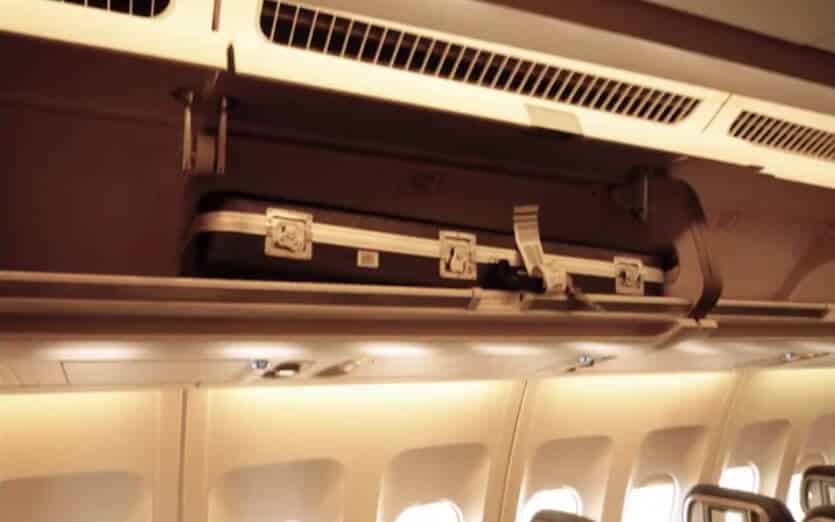As a music producer and studio owner, I’ve often found myself 30,000 feet in the air, creating melodies alongside the hum of jet engines. Taking keyboards on flights has become second nature to me, from compact MIDI controllers to full-sized digital pianos.
This article combines practical advice with personal anecdotes, covering everything from navigating TSA regulations to safely transporting your instrument.
Whether you’re a touring musician or a hobbyist eager to make music on the go, I’ll guide you through the ins and outs of flying with a keyboard.
Ready to change up your musical journey?
Let’s begin.
Can You Bring A Musical Keyboard On A Plane?
Yes, you can bring a musical keyboard on a plane. However, there are some restrictions on the size and weight of the keyboard, as well as the airline’s policies.
In general, musical instruments that fit in the overhead bin or under the seat in front of you can be brought as carry-on luggage.

Larger instruments may need to be checked as baggage. It’s always best to check with your airline in advance to confirm their specific policies.
Flying with a musical keyboard might seem like navigating a complex composition, but fear not, it’s not that hard.
As a music producer and home studio owner, I’ve faced this question head-on and soared through the skies with my beloved gear.
Let’s find out more experiences and practical tips on whether you can bring a musical keyboard on a plane and how to do it hassle-free.
Can You Carry A Midi Keyboard In An International Flight?
Yes, you can carry a MIDI keyboard on an international flight. The same restrictions on size and weight apply to domestic flights.

You may also need to pay an additional fee for checked baggage if your keyboard exceeds the airline’s weight limit.
Midi keyboards have become a staple for many musicians due to their portability and versatility.
Now, the burning question:
Can you whisk your compact midi keyboard across international skies?
The answer is a resounding yes, with a few considerations.
Midi keyboards, being smaller and lighter than their traditional counterparts, are quite travel-friendly.
AKAI Professional MPK Mini MK3
I’ve traveled on numerous international adventures with my trusty midi companion, and it’s been a harmonious experience.
The key (pun intended) is to ensure that your midi keyboard fits within your airline’s carry-on size limits. It’s like packing a symphony in your carry-on, but make sure it doesn’t exceed those pesky dimensions.
Once you’ve confirmed the size compatibility, the journey becomes smoother. A padded bag or case offers protection from the turbulence of travel.
This will ensure your musical partner reaches your destination unscathed. I’ve walked the talk on this one, and believe me, it’s worth the investment.
So, whether you’re heading to a gig, a recording session, or a musical escapade, your midi keyboard can easily accompany you across borders.
See Also: Is Ableton Live Used In Professional Studios in 2023?
Does The TSA Allow Musical Instruments On Flights?
Yes, the TSA allows musical instruments on flights. With that said, they may need to be inspected by a security officer.

If your instrument has any sharp or pointed parts, you may need to pack it in a separate container.
Navigating through airport security can feel like a challenging rhythm, but don’t let it strike a discord in your musical plans.
Top Tip: Take a look at the Samsonite Omni PC Hardside carry-on bag on Amazon for a versatile travel companion. This bag not only enhances your travel experience but also keeps your gear safe. Samsonite bags are light, strong, and spacious, offering a reliable solution. Rest assured, this carry-on easily fits the requirements of almost any airline.
Samsonite Omni PC Hardside
The Transportation Security Administration (TSA) embraces musicians and their instruments, including keyboards, as part of your carry-on or checked baggage.
But like any good musical piece, there are crescendos and decrescendos in this process.
Soft Guitar Backpack for Bass Acoustic & Classical Folk Electric Guitar Case


It’s quite common for security personnel to request you remove your keyboard from its case during the X-ray screening process.
This minor inconvenience ensures the safety of all passengers and ensures your instrument doesn’t hide any unexpected surprises. I’ve waltzed through security checkpoints with my keyboard in tow.
Just remember that it’s all part of the symphony of air travel.
See Also: 10 Tips For Travelling With Audio Equipment: Keep Your Gear Safe
Can I Take A Keyboard In My Carry On?
Yes, you can take a keyboard in your carry-on as long as it fits in the overhead bin or under the seat in front of you. If your keyboard is too large, you will need to check it as baggage.

The allure of bringing your keyboard as a carry-on item is undeniable – the convenience, the proximity, and the reassurance that your musical treasure is within arm’s reach.
The question lingers: Can you stow your keyboard overhead?
The answer, once again, is a positive note.
Keyboards, especially midi keyboards, generally fit the carry-on size criteria, sliding into overhead bins easily.
I’ve strolled through countless boarding gates with my trusted keyboard companion. And it’s been a smooth experience so far.
61-key Keyboard Case with Wheels
However, there’s a list of advice to heed.
Firstly, secure your keyboard meticulously within its case. Padding and cushioning become your best friends, guarding against any unexpected turbulence.
Secondly, if you’re on a smaller aircraft, consider the overhead space – you don’t want your musical partner to suffer from a cramped area.
Lastly, remember that while your keyboard might be your priority, the overhead space is shared, so be considerate to fellow passengers.
How To Travel With A Piano Keyboard?
Here are some tips on how to travel with a piano keyboard:
- Pack your keyboard in a hard-shell case to protect it from damage.
- Make sure your case is well-padded and that all the latches are secure.
- Label your case with your name and contact information.
- Check with your airline in advance to confirm their specific policies for musical instruments.
- If you are checking your keyboard as baggage, be sure to pack it in a way that it will not be damaged by other luggage.
- Bring a copy of your keyboard’s serial number with you in case it is lost or damaged.
Now, if you’re aiming to travel with a full-sized piano keyboard, you’re entering the realm of logistics.
While it might sound like fitting an orchestra into a garage, it’s entirely feasible with the right approach.
I’ve witnessed fellow musicians master this art, and here’s how you can too.
- Research is key. Each airline dances to its own melody of policies regarding large musical instruments. Some may require you to purchase an extra seat for your keyboard, while others might allow you to check it in as oversize baggage. A phone call to the airline in advance can save you a concerto of troubles at the airport.
- Investing in a rugged and reliable case is your next step. Your piano keyboard isn’t just an instrument; it’s a cherished possession. A sturdy case shields it from the turbulence of travel and ensures it reaches your destination unscathed. Remember, this investment not only protects your instrument but also your peace of mind.
- Brace for the adventure. Packing a piano keyboard isn’t merely about logistics; it’s a voyage of safeguarding your passion. With a blend of research, preparation, and determination, you’ll be playing your melodies on foreign shores in no time.
Which Musical Instruments Are Allowed On Airplanes?
The following musical instruments are generally allowed on airplanes as carry-on baggage, as long as they can fit in the overhead bin or under the seat in front of you:
- Violins

- Cellos
- Guitars
- Flutes
- Clarinets
- Trumpets
- Trombones
- Saxophones
- Keyboards
- Drums (if disassembled and packed in a hard case)

Larger instruments, such as grand pianos and harps, can be transported as checked baggage, but you may need to pay a special fee.
You should also check with your airline in advance to make sure that they will allow your instrument on board.
Here are some additional tips:
- If you are only traveling a short distance, you may be able to bring your piano keyboard as carry-on luggage. However, most airlines have restrictions on the size and weight of carry-on luggage, so be sure to check with your airline before you pack.
- If you are traveling with a hard case, you may need to check it at the oversized luggage counter. This will usually incur an additional fee.
- Be prepared to unpack your piano keyboard for inspection by security personnel.
- If you are traveling internationally, you may need to get a carnet for your piano keyboard. A carnet is an international customs document that will allow you to bring your keyboard into the country without paying import duties. It’s also referred to as a “Passport for goods“
Flying with it isn’t a mere journey; it’s an expedition of melodies across the globe. I’ve played the waiting game at boarding gates, gingerly securing my keyboard under the seat.
I’ve experienced the joy of fellow passengers glancing curiously at my keyboard, sparking conversations that transcend language barriers.
It’s these moments that remind me of the universality of music, the language that binds us all.
So, as I’ve carried my musical companion on countless flights, I’ve come to realize that my keyboard isn’t just an object; it’s a bridge between my passion and the world.
Summing It Up – Bring Musical Keyboard On A Plane
Whether you’re jamming with a MIDI keyboard or daring to take a piano on board, the skies are your stage.
Armed with the TSA’s blessing and a dash of preparation, your musical journey can harmonize with your flight.
Take your keys, share your music, and let the sky become your audience. Remember, the world is your concert hall, and your keyboard is your ticket to a symphony of experiences.
Can I bring a keyboard on a plane as carry-on luggage?
Yes, you can bring a keyboard on a plane as carry-on luggage, provided it fits within the airline’s size restrictions for overhead bins or under-seat storage. Always check with your specific airline for their policies on musical instruments, as regulations may vary.
Do I need a special case for flying with a keyboard?
While not strictly required, a sturdy, padded case is highly recommended when flying with a keyboard to protect your instrument from potential damage during transit. For larger keyboards, a hard-shell case may be necessary, especially if you’re checking the instrument as baggage.
How do I navigate TSA security with a keyboard?
The TSA allows musical instruments through security checkpoints, but be prepared to remove your keyboard from its case for X-ray screening. Inform the security officer if your keyboard has any sharp or pointed parts, and arrive at the airport early to allow extra time for this process.
Are there additional fees for bringing a keyboard on a flight?
This depends on the airline and the size of your keyboard. If your instrument fits within carry-on size limits, you typically won’t incur extra fees, but larger keyboards that need to be checked may incur oversized baggage fees.
What precautions should I take when flying internationally with a keyboard?
When flying internationally, check both departing and returning flight policies, and be aware of customs regulations in your destination country. Consider getting a carnet for your keyboard to avoid import duties, and ensure it’s well-protected for a potentially longer journey.

Mike is a skilled musician, guitar technician, and music producer with a passion for audio and gear. He excels in teaching guitar, editing podcasts/videos, and creating captivating soundscapes using cutting-edge hardware, software, and plugins. Mike’s talent and commitment make him highly sought-after in the industry, inspiring fellow musicians worldwide.





